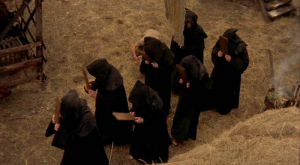
 ET’S FACE IT: most of us are not making the switch to a Gregorian Ordinary and Propers anytime soon. That doesn’t mean that Gregorian Chant shouldn’t hold its rightful place of esteem in the Church’s musical treasury; it’s simply an acceptance of reality that will keep you sane. It also doesn’t mean that meaningful progress isn’t to be made here and there. There are concrete steps you can take to improve the music in your parish’s liturgy, and even some stealthy ways to sneak in some of the musical heritage that belongs there.
ET’S FACE IT: most of us are not making the switch to a Gregorian Ordinary and Propers anytime soon. That doesn’t mean that Gregorian Chant shouldn’t hold its rightful place of esteem in the Church’s musical treasury; it’s simply an acceptance of reality that will keep you sane. It also doesn’t mean that meaningful progress isn’t to be made here and there. There are concrete steps you can take to improve the music in your parish’s liturgy, and even some stealthy ways to sneak in some of the musical heritage that belongs there.
Yesterday, we celebrated the funeral of a priest in our Archdiocese. The family did not have any requests, so planning the music for the liturgy was up to me (NOTE: cherish these opportunities. It’s rare that you don’t have a grieving family’s requests to accommodate). I also saw this as an opportunity to model for many diocesan priests who would be in attendance what is possible for simple, approachable music at the average parish funeral. Here was our selection. Yes, I am aware that preludes are not prescribed for a funeral liturgy, but they have become normal as families gather.
PRELUDE: 1. Meditation sur “Dies Irae” et “Lux Aeterna” by Marie Joseph Erb 2. Requiem aeternam by Gerald Near
ENTRANCE ANTIPHON: Requiem aeternam, set metrically to LAND OF REST, from Christoph Tietze’s Introit Hymns. (Get that book. Some settings are better than others, but it is a very parish-friendly resource for easily working in some propers.)
RESPONSORIAL PSALM: Psalm 23, setting by Jeff Ostrowski from the Chabanel Psalms collection found on this very website.
ALLELUIA: Mode VI, proper verse.
OFFERTORY: O Jesus, Lord, Increase Our Faith (set to ERHALT UNS, HERR). A beautiful hymn text from GIA’s Hymnal of the Hours. If I had to repeat this funeral, this is the only portion I would consider altering, not because I was unhappy with this selection, but because there were several equally good options, including a few settings of the proper Offertory.
MASS ORDINARY: Chants from the 3rd edition of the Roman Missal. I wonder how many people even realized that it’s the normative ordinary for the Mass of the Dead.
COMMUNION ANTIPHON: My own setting, found here. While all of my antiphon settings match the Gregorian propers modally, this is the only one that sticks with the chant melody pretty strictly. I played the Lux aeterna from the Nova Organi Harmonia as an introduction to my setting.
SONG OF FAREWELL: Proulx’s setting of Saints of God. This one is an old warhorse, but there are few better vernacular settings of this text. If you don’t want to use the OLD HUNDREDTH version (who can get excited about that?), or shudder the “O Danny Boy” version, use this one. Many places don’t use the proper text at this point in the liturgy, and this is both an easy setting and quite a good harmonization by Proulx.
PROCESSION TO THE PLACE OF COMMITAL: In paradisum in English, then in Latin. The Worship hymnals have a decent harmonization of this by Richard Proulx, which is reminiscent of the Nova Organi Harmonia style. Also, this is a relatively short chant for a fairly long procession, so doing it twice helps.
POSTLUDE: I normally don’t play postludes for funerals, but I tagged the above piece because it takes quite some time to march the family and 50-plus priests out of a church. I used Gerald Near’s setting of In paradisum.
None of this, including the organ pieces, is beyond the reach of even an early-intermediate organist (I would not call myself advanced). All in all, we sang almost all of the proper and ordinary from the Mass of the Dead, and I wonder how many priests even realized it. Funerals are a good time to re-introduce the Church’s musical tradition, and I have literally had families thank me for using In paradisum. You just can’t beat it for a more appropriate piece.
